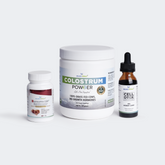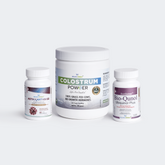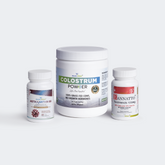Herbal Detox: Best 9 Herbs for Detoxification
Estimated Reading Time: 7 minutes
|Are you looking for a gentle detox supplement? What if your favorite herb holds the secret to cleansing your body at the cellular level?
It is hard to believe that the average person carries over 200 industrial chemicals and pollutants in their body. Even newborns enter this world with numerous toxins in their bodies. Quite often, the symptoms of toxin exposure go unnoticed at the start, turning into fatal diseases like cancer or organ damage in later stages.
Therefore, detoxification or body cleansing is a vital protocol for vitality and overall well-being. Detoxification is the natural process by which our body regularly cleanses cells and eliminates toxins, such as heavy metals. While it involves natural pathways, herbal detox can stimulate the process. Unlike chelating therapies and chemical detoxifying agents, herbs offer a safer and gentler alternative. Here is a blog compiling the best herbs for detoxification. Do you know what the best part is? Most of these herbs are easily available at your local grocery store or online, making them accessible to you.
How Herbal Detox Cleanses Your Body
Let's start the blog by understanding how herbal detox works. Every minute, our body is exposed to hundreds of toxins and heavy metals. These toxins are present everywhere, from food to soil, water, and air. Most toxins contain free radicals and reactive oxygen species that interfere with cellular vitality.
While it's not possible to avoid exposure to such harmful substances altogether, there is a bright side. Our body eliminates toxins and heavy metals through its natural pathways, including the lungs, kidneys, liver, and skin. Herbal detox supports these pathways primarily because of its antioxidant and anti-inflammatory properties.
You might be surprised to find out that 1 in 5 Americans use herbal supplements for natural detoxification. Let's learn more about these herbs.
9 Best Natural Herbs for Detoxification
Traditional medicinal systems, such as Ayurveda and European herbalism, use nearly 200 herbs to support natural detoxification. Here is the list of commonly used herbs for body cleansing.
-
Schisandra
Schisandra berry is a vine plant native to Northern China. It is also known as the magnolia berry or the five-flavor fruit. According to Traditional Chinese Medicine, it is the only fruit with all five tastes: bitter, pungent, salty, sour, and sweet.
Studies show that Schisandra boosts intracellular glutathione levels, improving natural detoxification. Additionally, it activates the Nrf2 pathway, i.e., the body's natural response to oxidative stress, promoting cellular vitality.
In Traditional Chinese Medicine (TCM), Schisandra was historically known as the "herb of immortality." It is believed to promote mortality and longevity in its tonic form.
-
Holy Basil
In Ayurvedic traditions, Holy Basil is a primary herb for natural detoxification. Also known as Tulsi, Holy Basil is native to tropical and subtropical regions of Asia, Australia, and the western Pacific. It can help eliminate toxins, leading to clearer skin.
Tulsi is rich in eugenol, ursolic acid, and rosmarinic acid, which act as powerful herbal detoxifying agents. It protects the body against chemical stress from pollutants and heavy metals.
Holy Basil is often referred to as the "Queen of Herbs" due to its exceptional healing properties. In an Indian household, it is even worshipped for spiritual reasons.
-
Red Clover
Red clover is a purplish-red flowering plant native to Asia, Europe, and North Africa. Since ancient times, it has been used as a blood cleanser. It contains isoflavones and flavonoids linked to antioxidant properties.
Recent research highlights that red clover can reduce the frequency of hot flashes in peri and post-menopausal women. Furthermore, in clinical trials, red clover has been found to be an adjuvant to cancer treatment, supporting traditional anticancer medicines.
Red Clover is a popular ingredient found in detox teas, health supplements, and even in topical skin healing medications.
-
Nettle Leaf
Nettle leaf, scientifically called Urtica dioica, is characterized by stinging hairs on its leaves and stems. Plants hold an important place in both culinary and medicinal applications. As an herbal detox, nettle leaf helps purify the blood and improve kidney function.
It also modulates mitochondrial function and the body's natural antioxidant defense mechanisms. Beyond the kidney, nettle leaves also demonstrate hepatoprotective effects and maintain liver cell viability even under excessive oxidative stress.
Nettle is often referred to as a "superfood" due to its impressive nutrient profile. It’s packed with vitamins, minerals, and antioxidants.
-
Dandelion
Ever mesmerized by the delicacy of dandelions? This wild plant also holds natural anti-inflammatory and detoxifying properties. In Western countries, dandelion is one of the popular herbs for detoxification. Traditionally, dandelion is used to treat gastrointestinal issues like dyspepsia, anorexia, gastritis, and enteritis.
The bitter compounds present in dandelions help break down fats and flush waste, supporting overall digestive metabolism. Recent studies even show that dandelion root extract can selectively induce autophagy in cancer cells without significantly affecting normal cells.
In ancient European folklore, dandelions were believed to have magical properties. It is often considered a symbol of love and happiness.
-
Burdock Root
Burdock root, also known as Greater Burdock, is a common herb used for detoxification in Traditional Chinese Medicine. It supports the removal of natural toxins and healthy nutrient assimilation. Additionally, it may improve skin texture and appearance.
Burdock contains compounds like insulin and phenolic acids that possess antioxidant and anti-inflammatory effects. In preclinical trials, these roots have also shown potent inhibitory effects on the growth of tumors, including pancreatic carcinoma.
Burdock Root has natural inulin. It is a prebiotic fiber that not only supports gut detoxification, but it also helps the body remove heavy metals naturally.
-
Milk Thistle
Milk thistle is a commonly used herb for liver detox. It is a purple flowering herb native to Mediterranean countries. Unlike forceful cleansers, milk thistle is a gentle approach that protects liver cells from oxidative stress. It may also promote blood detoxification by removing toxins from the bloodstream.
Milk thistle contains the compounds silybin, silydianin, and silychristin, known as silymarin. Silymarin has been shown to increase glutathione levels in the liver by up to 35% in some studies. It also inhibits toxin binding in liver cell membranes, acting as a toxin blockade agent. In recent times, it has been used for treating toxin-induced hepatic diseases, such as alcoholic fatty liver.
Milk Thistle contains silymarin, which may increase glutathione. Glutathione is also known as the body’s "master detox antioxidant."
-
Indian Ginseng
Ginseng, also known as Ashwagandha, is a prominent herb used for body cleansing in the Indian Ayurvedic system. Beyond its ability to improve testosterone and male infertility, Ashwagandha also supports the body's natural detoxification processes.
Ginseng roots improve oxygen utilization in the blood, adding to overall cellular vitality. They also strengthen the digestive metabolism, which is important for removing toxins and waste from the body.
Indian Ginseng, also known as Ashwagandha, can reduce cortisol levels, helping the body adapt to stress and promoting a sense of calm.
-
Turmeric
Turmeric, scientifically known as Curcuma longa, is a golden-orange spice that has versatile culinary applications. It can add color, flavors, and even nutrition to signature dishes. Beyond kitchen uses, turmeric roots are often considered a detox herb.
Turmeric contains curcumin, an antioxidant and anti-inflammatory agent that regulates blood circulation. It supports bile production and liver detoxification. Additionally, a few studies support curcumin's chelating effects, which bind with toxins and remove them from the body.
Curcumin, in turmeric, can inhibit certain enzymes and molecules that contribute to inflammation, including COX-2 and NF-κB.
Now that you know the names of herbs you can use for body cleansing, do you know how to incorporate them into your routine?
How To Add Herbs for Detoxification
There are multiple ways you can add natural herbs for detoxification. You can use herbal extract or tea or even add it to your recipe. A few populations also use these herbs as spices or to sprinkle on salads. However, remember that there is still limited scientific evidence that examines the exact effectiveness and benefits of these herbs. Furthermore, since it is 100% natural, you will need to be patient and consistent with the process.
Is There Any Other Way
Beyond herbal detox, consider adding natural detox supplements to your routine. Cell D-Tox by Wellness Extract is a liquid mineral detoxifying supplement. Combining the power of organic humic and fulvic acids and zeolite, Cell D-Tox is a natural and effective alternative.
Humic and fulvic acids offer binding sites for heavy metals, helping to eliminate them from the body. The supplement also supports nutrient absorption, liver metabolism, and gut health, contributing to overall vitality.
Final Words
The above-stated herbs have shown incredible health potential, supporting natural detoxification. They have been used to cleanse the body at the cellular level since ancient times. Incorporating these herbs into your routine may eliminate toxins and impurities from the bloodstream. Moreover, you can also add Cell D-Tox, a mineral detox supplement, to support the herbal detox action.
Disclaimer: This content is for informational purposes only and is not intended as medical advice. These statements have not been evaluated by the FDA. Products mentioned are not intended to diagnose, treat, cure, or prevent any disease.
Sources
-
Wang, X., Zhang, H., Chen, X., & Yang, Y. (2014). Schisandra chinensis: A review of pharmacological effects. December 2014. Available: https://pmc.ncbi.nlm.nih.gov/articles/PMC4277124/
-
Imran, M., Rauf, A., Abu-Izneid, T., et al. (2021). Red clover (Trifolium pratense L.) as a potential dietary source of isoflavones: A review. August 2021. Available: https://pubmed.ncbi.nlm.nih.gov/34392659/
Muceniece, R., Revina, B. L., Kviesis, J., et al. (2025). Nettle Leaf Water Extracts for Hepatoprotection:




































